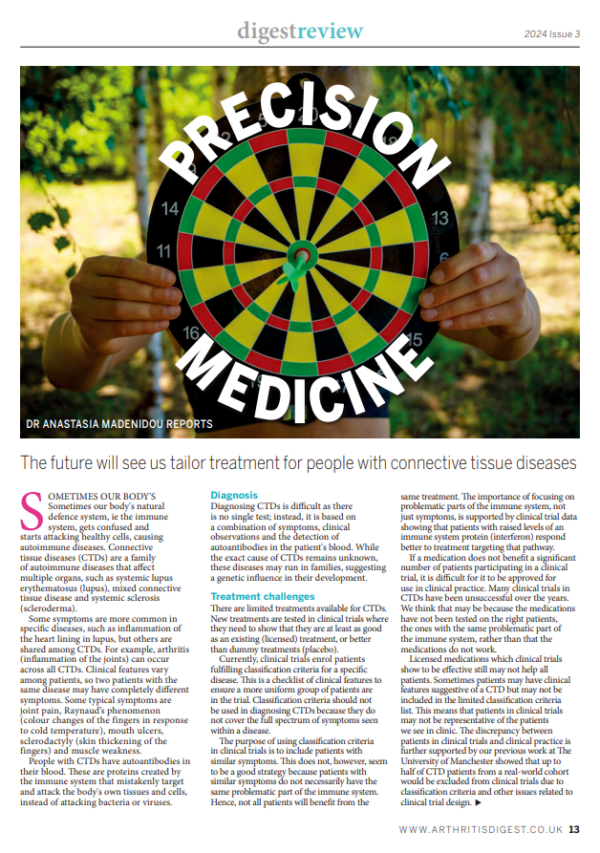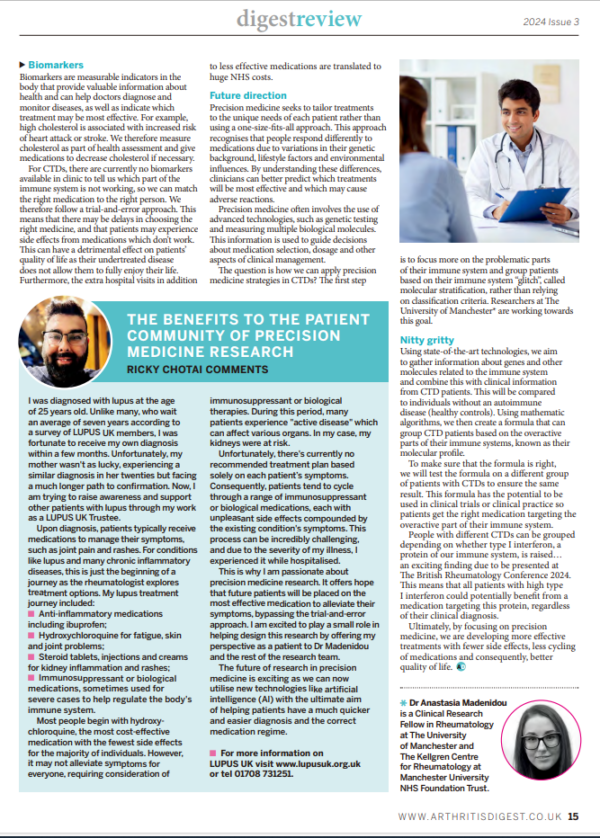Tailoring treatment to the individual: Precision medicine in connective tissue diseases – Dr Anastasia Madenidou speaks to Arthritis Digest
Arthritis Digest is a magazine for people with arthritis that highlights the latest relevant research and reviews topical issues.
Continuing regular contributions from our Rheumatic and Musculoskeletal Diseases theme researchers, Dr Anastasia Madenidou, Clinical Research Fellow in Rheumatology at The University of Manchester and The Kellgren Centre for Rheumatology at Manchester University NHS Foundation Trust, explains why a more personalised approach to choosing treatment is important in the successful management of connective tissue diseases and how her research contributes to this.
Sometimes our body’s natural defence system, ie the immune system, gets confused and starts attacking healthy cells, causing autoimmune diseases. Connective tissue diseases (CTDs) are a family of autoimmune diseases that affect multiple organs, such as systemic lupus erythematosus (lupus), mixed connective tissue disease and systemic sclerosis (scleroderma).
Some symptoms are more common in specific diseases, such as inflammation of the heart lining in lupus, but others are shared among CTDs. For example, arthritis (inflammation of the joints) can occur across all CTDs. Clinical features vary among patients, so two patients with the same disease may have completely different symptoms. Some typical symptoms are joint pain, Raynaud’s phenomenon (colour changes of the fingers in response to cold temperature), mouth ulcers, sclerodactyly (skin thickening of the fingers) and muscle weakness.
People with CTDs have autoantibodies in their blood. These are proteins created by the immune system that mistakenly target and attack the body’s own tissues and cells, instead of attacking bacteria or viruses.

Diagnosis
Diagnosing CTDs is difficult as there is no single test; instead, it is based on a combination of symptoms, clinical observations and the detection of autoantibodies in the patient’s blood. While the exact cause of CTDs remains unknown, these diseases may run in families, suggesting a genetic influence in their development.
Treatment challenges

There are limited treatments available for CTDs. New treatments are tested in clinical trials where they need to show that they are at least as good as an existing (licensed) treatment, or better than dummy treatments (placebo).
Currently, clinical trials enrol patients fulfilling classification criteria for a specific disease. This is a checklist of clinical features to ensure a more uniform group of patients are in the trial. Classification criteria should not be used in diagnosing CTDs because they do not cover the full spectrum of symptoms seen within a disease.
The purpose of using classification criteria in clinical trials is to include patients with similar symptoms. This does not, however, seem to be a good strategy because patients with similar symptoms do not necessarily have the same problematic part of the immune system. Hence, not all patients will benefit from the same treatment. The importance of focusing on problematic parts of the immune system, not just symptoms, is supported by clinical trial data showing that patients with raised levels of an immune system protein (interferon) respond better to treatment targeting that pathway.
If a medication does not benefit a significant number of patients participating in a clinical trial, it is difficult for it to be approved for use in clinical practice. Many clinical trials in CTDs have been unsuccessful over the years. We think that may be because the medications have not been tested on the right patients, the ones with the same problematic part of the immune system, rather than that the medications do not work.
Licensed medications which clinical trials show to be effective still may not help all patients. Sometimes patients may have clinical features suggestive of a CTD but may not be included in the limited classification criteria list. This means that patients in clinical trials may not be representative of the patients we see in clinic. The discrepancy between patients in clinical trials and clinical practice is further supported by our previous work at The University of Manchester showed that up to half of CTD patients from a real-world cohort would be excluded from clinical trials due to classification criteria and other issues related to clinical trial design.
Biomarkers
Biomarkers are measurable indicators in the body that provide valuable information about health and can help doctors diagnose and monitor diseases, as well as indicate which treatment may be most effective. For example, high cholesterol is associated with increased risk of heart attack or stroke. We therefore measure cholesterol as part of health assessment and give medications to decrease cholesterol if necessary.
For CTDs, there are currently no biomarkers available in clinic to tell us which part of the immune system is not working, so we can match the right medication to the right person. We therefore follow a trial-and-error approach. This means that there may be delays in choosing the right medicine, and that patients may experience side effects from medications which don’t work. This can have a detrimental effect on patients’ quality of life as their undertreated disease does not allow them to fully enjoy their life. Furthermore, the extra hospital visits in addition to less effective medications are translated to huge NHS costs.
Future direction
Precision medicine seeks to tailor treatments to the unique needs of each patient rather than using a one-size-fits-all approach. This approach recognises that people respond differently to medications due to variations in their genetic background, lifestyle factors and environmental influences. By understanding these differences, clinicians can better predict which treatments will be most effective and which may cause adverse reactions.
Precision medicine often involves the use of advanced technologies, such as genetic testing and measuring multiple biological molecules. This information is used to guide decisions about medication selection, dosage and other aspects of clinical management.
The question is how we can apply precision medicine strategies in CTDs? The first step is to focus more on the problematic parts of their immune system and group patients based on their immune system “glitch”, called molecular stratification, rather than relying on classification criteria. Researchers at The University of Manchester* are working towards this goal.

Nitty gritty
Using state-of-the-art technologies, we aim to gather information about genes and other molecules related to the immune system and combine this with clinical information from CTD patients. This will be compared to individuals without an autoimmune disease (healthy controls). Using mathematic algorithms, we then create a formula that can group CTD patients based on the overactive parts of their immune systems, known as their molecular profile.
To make sure that the formula is right, we will test the formula on a different group of patients with CTDs to ensure the same result. This formula has the potential to be used in clinical trials or clinical practice so patients get the right medication targeting the overactive part of their immune system.
People with different CTDs can be grouped depending on whether type I interferon, a protein of our immune system, is raised… an exciting finding due to be presented at The British Rheumatology Conference 2024. This means that all patients with high type I interferon could potentially benefit from a medication targeting this protein, regardless of their clinical diagnosis.
Ultimately, by focusing on precision medicine, we are developing more effective treatments with fewer side effects, less cycling of medications and consequently, better quality of life.
The benefits to the patient community of precision medicine research
Ricky Chotai comments

I was diagnosed with lupus at the age of 25 years old. Unlike many, who wait an average of seven years according to a survey of LUPUS UK members, I was fortunate to receive my own diagnosis within a few months. Unfortunately, my mother wasn’t as lucky, experiencing a similar diagnosis in her twenties but facing a much longer path to confirmation. Now, I am trying to raise awareness and support other patients with lupus through my work as a LUPUS UK Trustee.
Upon diagnosis, patients typically receive medications to manage their symptoms, such as joint pain and rashes. For conditions like lupus and many chronic inflammatory diseases, this is just the beginning of a journey as the rheumatologist explores treatment options.
My lupus treatment journey included:
- Anti-inflammatory medications including ibuprofen;
- Hydroxychloroquine for fatigue, skin and joint problems;
- Steroid tablets, injections and creams for kidney inflammation and rashes;
- Immunosuppressant or biological medications, sometimes used for severe cases to help regulate the body’s immune system.
Most people begin with hydroxychloroquine, the most cost-effective medication with the fewest side effects for the majority of individuals. However, it may not alleviate symptoms for everyone, requiring consideration of immunosuppressant or biological therapies. During this period, many patients experience “active disease” which can affect various organs. In my case, my kidneys were at risk.
Unfortunately, there’s currently no recommended treatment plan based solely on each patient’s symptoms. Consequently, patients tend to cycle through a range of immunosuppressant or biological medications, each with unpleasant side effects compounded by the existing condition’s symptoms. This process can be incredibly challenging, and due to the severity of my illness, I experienced it while hospitalised.
This is why I am passionate about precision medicine research. It offers hope that future patients will be placed on the most effective medication to alleviate their symptoms, bypassing the trial-and-error approach. I am excited to play a small role in helping design this research by offering my perspective as a patient to Dr Madenidou and the rest of the research team.

The future of research in precision medicine is exciting as we can now utilise new technologies like artificial intelligence (AI) with the ultimate aim of helping patients have a much quicker and easier diagnosis and the correct medication regime.
For more information on LUPUS UK visit www.lupusuk.org.uk or tel 01708 731251.